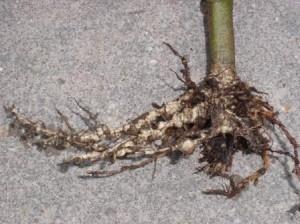

Okra can be relatively easy to grow, unless you have nematodes. Nematodes are a serious pest of okra and can damage a stand, greatly decreasing production of pods. Nematodes are microscopic round worms naturally found in north Florida soil. These worms can wreak havoc on a wide range of horticultural and agronomic plants (tomatoes, sweet potatoes, strawberries, collards, and cotton just to name a few.)
Not all nematodes are bad. Some feed on soil-borne pests and many help recycle nutrients by aiding in the decomposition of organic matter. Okra roots, however, are very susceptible to the damage caused by root knot nematodes and sting nematodes.
There are some “typical” nematode damage patterns which will aid diagnosing okra plant decline. Foliar symptoms include early wilting, leaf yellowing, and a general weakening look to the plant. Plant growth can be stunted and irregular with patchy areas of unhealthy looking plants.
The obvious signs of nematodes occur on the roots. Sting nematodes cause the plant to produce a tight mass of short roots, while root knot nematodes cause galls to form on the root (see picture). These galls look like swollen areas on the root. The galls will succumb to bacteria, leading to the roots rotting. With root damage leading to reduced water and nutrient uptake, the leaves suffer and the plant will struggle to put on usable pods.
Controlling nematodes is a difficult task for commercial producers and home gardener. For management options and more information, please contact Libbie Johnson or Beth Bolles or see Nematode Management in Okra.
 0
0
